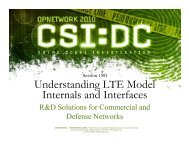Automated Axon Tracking of 3D Confocal Laser Scanning ...
Automated Axon Tracking of 3D Confocal Laser Scanning ...
Automated Axon Tracking of 3D Confocal Laser Scanning ...
Create successful ePaper yourself
Turn your PDF publications into a flip-book with our unique Google optimized e-Paper software.
In the datasets containing branching structures, the hybrid algorithm will switch to the crosssectionalanalysis only where an axon cross-over is encountered or at axon branch points. Oncethe algorithm switches to the cross-sectional analysis, these two cases can be easily distinguishedfrom each other. If a branch point is encountered while tracking in the cross-sectional sequence,there will be a significant change in the size <strong>of</strong> the axon cross-section, since the axon crosssectionwill split into two parts. The user can then manually identify if this change is due to abranch point or caused by a sudden change <strong>of</strong> orientation <strong>of</strong> the axon with respect to the imagingplane.The algorithm proposed in the paper requires the structures in the dataset not to be orientedalong the imaging plane. This is required since if the axons are aligned parallel to the imagingplane, their cross-sections randomly appear and vanish if the images in the dataset are viewed ina sequence. When the axons are aligned this way, partially or completely, the following changescan improve the algorithm’s ability to adapt:• If all the axons in the dataset are aligned along the imaging plane, the dataset can be re-insampled normal to the imaging plane and the cross-sectional analysis can be performedthis direction. If some parts <strong>of</strong> the axon bundles are oriented along the imaging plane, thedataset can be subdivided into smaller subsets and each <strong>of</strong> them can be individually analyzed.By looking at the MIP image, the user can determine which subsets <strong>of</strong> the dataset need to bere-sampled. The centerlines from each <strong>of</strong> the subsets can then be merged together to form thecomplete centerline model.• Another way to solve this problem is to adopt cross-sectional analysis throughout the datasetand to re-slice the dataset at every step <strong>of</strong> the process. Once the orientation <strong>of</strong> an axon isfound at a particular point, the next cross-sectional slice is determined after slicing the33















